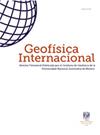Detection of total water mass changes in the Patagonian glaciers area by satellite gravimetry
IF 0.7
4区 地球科学
Q4 GEOCHEMISTRY & GEOPHYSICS
引用次数: 2
Abstract
Despite present efforts to better understand glacier changes and their trends, the satellite gravimetry is a powerful tool still not applied in depth to study relatively large areas in the Andes of Argentina and Chile. In this work the mass variations of the Patagonian Icefield are analyzed together with the decrease trends of the ice layer in the region. The purpose of this study is to demonstrate the GRACE satellite mission (Gravity Recovery and Climate Experiment) ability to detect the water storage changes over the glaciers area. Furthermore, the variations of the hydrometric level of some Patagonian lakes were monitored by combining satellite altimetry data and in situ measurements with the observed water mass variations. Data from GRACE was used to estimate gravity trends, and high-resolution CSR GRACE RL05 mascon solutions were used to analyze the water storage change of the icefields in the region under study for the 2002-2017 period. Virtual stations from satellite altimetry obtained from a lake database and also hydrometric height data from in situ stations, located at Patagonian lakes in Argentina and Chile, were also used in order to compare the TWS from GRACE to the water level of the specific lakes. Additionally, correlation coefficients were determined at each station. The results show a significant water storage decrease in the Icefield area, and they also demonstrate that the ice melt in southern Patagonia (of about 6 cm/year) tends to be more pronounced than in the northern region.用卫星重力法探测巴塔哥尼亚冰川地区总水质量变化
尽管目前正在努力更好地了解冰川变化及其趋势,但卫星重力测量是一种强大的工具,仍未深入应用于研究阿根廷和智利安第斯山脉相对较大的地区。在这项工作中,分析了巴塔哥尼亚冰原的质量变化以及该地区冰层的减少趋势。本研究的目的是证明GRACE卫星任务(重力恢复和气候实验)检测冰川地区蓄水变化的能力。此外,通过将卫星测高数据和现场测量与观测到的水量变化相结合,监测了一些巴塔哥尼亚湖泊的水文水位变化。GRACE的数据用于估计重力趋势,高分辨率CSR GRACE RL05 mascon解决方案用于分析2002-2017年研究区域冰原的蓄水变化。为了将GRACE的TWS与特定湖泊的水位进行比较,还使用了从湖泊数据库获得的卫星测高的虚拟站,以及来自阿根廷和智利巴塔哥尼亚湖泊原位站的水文高度数据。此外,还确定了每个站点的相关系数。结果显示,冰原地区的蓄水量显著减少,还表明巴塔哥尼亚南部的冰融化(约6厘米/年)往往比北部地区更明显。
本文章由计算机程序翻译,如有差异,请以英文原文为准。
求助全文
约1分钟内获得全文
求助全文
来源期刊

Geofisica Internacional
地学-地球化学与地球物理
CiteScore
1.00
自引率
0.00%
发文量
23
审稿时长
>12 weeks
期刊介绍:
Geofísica internacional is a quarterly scientific journal that publishes original papers that contain topics that are interesting for the geophysical community. The journal publishes research and review articles, brief notes and reviews books about seismology, volcanology, spacial sciences, hydrology and exploration, paleomagnetism and tectonic, and physical oceanography.
 求助内容:
求助内容: 应助结果提醒方式:
应助结果提醒方式:


